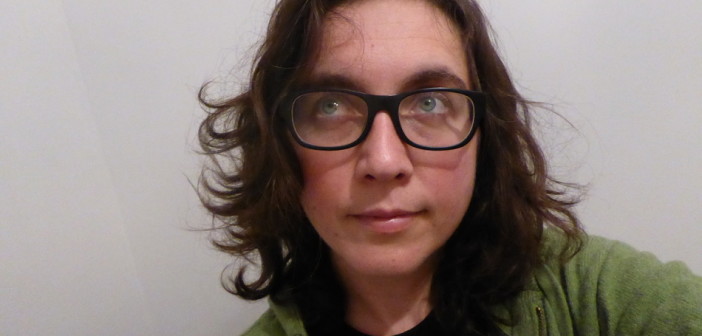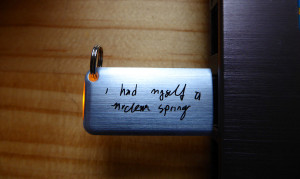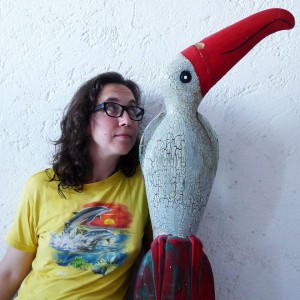Kate Carr is an Australian sound artist living in the United Kingdom. She is the founder of the flaming pines label and her works predominately investigate the relationship between people and place. She is a field recordist and an experimental composer and is involved in the conceptual musical field of sonic mapping.
Innerversitysound: I had myself a nuclear spring opens akin to many a field recording, a presentation of the bucolic but it is very soon that it becomes clear that the subject is the conjunction of the natural and the synthetic. Your recording suggests itself as an environmental statement? Would you tell us a bit about this aspect of your work?
Kate Carr: It wasn’t so much an environmental statement. In some of my other works, or in some of the works I have done in the series with Flaming Pines, like Birds of a Feather or Rivers home, they have been very specifically about environmental concerns and all the threats that people know are faced by river systems or particular bird species. With nuclear spring, even though I am opposed to nuclear power, i suppose, it was more about the unusualness of that habitat and exploring different ideas around imperfect habitats. I did a bit of a set of sounds on my soundcloud page, I think I even called it imperfect habitats. It was just looking at all the different sites in that town that the animal world had made a really good go of proliferating in, but which if you look at from an environmental perspective are really pretty gross in some ways. The TGV trains shooting by or the massive highway out the back and the obvious thing one thinks of is the massive nuclear power plant in the hinterland. So I was really interested in the hybridity of that site and I suppose the flaws of it as an ecosystem but also how well species were doing and making the most of it.
Innerversitysound: Your press material describes a meeting between yourself and the socialist ex-mayor of the region where the recordings are made. There seems to be a suggested thread connecting the 1968 youth uprising in Paris, environmental politics, the election of the nationalist front and your interest in recording the wildlife of the wetlands. Can we expect more clear statements of this political focus in your work in the future?
Kate Carr: What I was trying to do in those liner notes when I was talking about the mayor and the rise of the national front in Marnay-sur-Seine was to underline the contrast that I saw between the ways in which the natural worlds to use this term had adapted to this fairly imperfect set of situation whereas the human inhabitants of Marnay-sur-Seine seemed to be having a much more mixed experience. There was a lot of decaying sites in that place, there has been a lot of industry loss and there has been a lot of industry loss. It was a very small town, the only hotel had closed down, the café had closed down and the church was boarded up. So it wasn’t a town that was doing very well, so I think you often find that in Australia, we have experienced that it is those sort of towns that can often look to solutions with the far right. And I guess that was my reading of the situation. She was a lovely woman the mayor and her daughter ran another residency program in that town as well and it was just a shame to see this kernel of something amazing that was happening within the town with her and her daughter and her daughters colleagues who were also running the residency program contrasted to the less than positive things that were happening there. I am not planning any big opus of my politics or manifesto or something like that but I have been working with different individuals on releases that reference the politics of their particular countries or places and in particular I was talking about the Iranian release which is called Absence, and the title itself refers to the fact that some Iranian artists have found it hard to exist within the social and cultural context of their country. So while the pieces themselves aren’t explicitly political, in terms of they don’t have lyrics or is there any extra material that accompanies them that draws the listener’s attention to the political situation it is very much a product of that place and those politics. And those are the sort of releases that I am definitely very interested in.
Innerversitysound: Through your blog site Gleaming Silver Ribbon as well as your soundcloud stream there is indications of the development of your skill as a field recordist. Has this moved you into the more traditional work in the domain, nature documentaries and installation pieces, or is your focus more solidly within the experimental art field.
Kate Carr: I definitely have had an increasing interest in doing, for want of a better term, more technically proficient field recordings. And being based in the UK has opened up possibilities; I was able to do a course with Chris Watson and Jez Riley-French on field recording and I do really admire Jez’s approach in particular and many field recordists utilise his specialist microphones and I myself do as well. With his hydrophones, with his contact microphones, with very unconventional recording techniques. So that’s something that I have been very interested in for a while, but I have been able to pursue it more being here. It hasn’t really led me to undertake or even look for work in terms of nature documentaries or anything like that but I have gotten work doing purely field recordings for theatre and I think obviously this skills development that I have been undertaking over the past year to year and a half has really helped me to be able to achieve that.
Innerversitysound: The chapter Music of the plants from the book Animal Music focuses on the practice of shamanism and this practice in South America, predominately as translated by Stephen Beyer. Is your interest in shamanism a live interest, a practice you are undergoing yourself?
Kate Carr: No, it definitely is not. It was something that I was very interested from initially speaking to Francisco Lopez, in doing his field recording course in the Amazon. And just trying to educate myself more around the different indigenous groups and cultural practices in the different countries that share the Amazonian system. So it definitely wasn’t something that I was wanting to pursue personally but it is very educative but it is also important to understand that there are very different ways of thinking about our relationship with the natural world and our relationships with the sounds of the natural world. Some of the practices of the shamans with their conception of learning the songs of particular animals or learning the songs of particular plants. I think it’s an amazing and provocative and very interesting idea. It’s obviously not something that speaks to me in my own cultural context but I very much appreciate it and was interested in it as another way in which the different cultures come to understand the world.
Innerversitysound: Shamanism is symptomatic of new age interests, often western people who hold this interest in this are described as Plastic Shaman and the writings of Carlos Castenada have been critiqued as cultural theft and even fraud. How can one separate out the actual cultural practice from the rife proliferation of this meme and its expression as substance abuse in the wider ambient music community?
Kate Carr: I think there are a lot of different aspects to that question you have asked and I don’t think it is exclusive specifically to shamanism that people from western cultures attempt to, well not attempt to but perhaps have a very superficial understanding of the importance of those cultural practices or use them in some ways as accessories to life and rob something of the integrity of those set of beliefs or set of practices. I suppose removing them from their cultural context does rob them of some of their cultural integrity and it’s something that’s criticised broadly around all sorts of things, around tourism, around different tattoos associated with particular ethnicities and white people simply plastering them on their bodies with no real understanding of their meaning or the appropriateness of them even using those symbols. In writing that article I wasn’t attempting to defend western engagement with shamanism or particularly to criticise it, because it’s not something that I know an enormous amount about. As I was saying to you my interest in that book was for me the unusualness of the practices that it described and the ways in which the shamans, and studying the shamans, was very centered on sounds and the sites in which they situated those sounds in those songs in terms of learning them from animals and learning them from plants was not something that I knew anything really about so I explored it in that article. But I do definitely take your point and I agree with you around the broader critiques of western appropriation of different culture.
Innerversitysound: You have been described as a curator of your label Flaming Pines. Can you tell us a bit about what output people should expect in the near future? Is there a direction or focus that you are following?
Kate Carr: Yes, I wanted to talk about Tiny Portraits which is a series of 3” singles that has just started and it is combined with a mapping project that is produced by the Iranian artist Arash Akbari. This is a project that is centered on explorations of sound and place. I have tried to encourage the artists involved to think a little bit outside the box to think about what sort of places they want to interrogate or convey through sound. So I have encouraged them to get away from some of the very traditional, and some would say clichéd ambient preoccupations with fields or beautiful parks or physical natural sites. That’s what I have been speaking with those artists about and in the first four singles there were some really interesting engaging pieces. I will just talk about two: Zen Jungle did one looking at a public square in Athens in which his written liner notes to accompany it was about the graffiti of that place and his attachment to it, and its symbolism in his childhood and also that sits in a very broader context with him in Greece with the massive social upheaval and change. And the Iranian Siavash Armini did a similar thing but with a public square in Iran. They have got the public address system there with the call to prayer and he was talking about the silence of the early morning and his efforts to gather something in that place. So I thought those were really great works and there are many singles that were ready to be produced, probably another ten I have already got on my computer that I have got to do some artwork for. Ranging from all around the globe so it’s something that I am really excited about, it’s focused on places that are often not given enough attention in the mainstream music press, like the releases form people in the Ukraine or in Georgia or Egypt. So I have worked really hard to build those networks with artists from these different places and they have come up with some really amazing pieces so that is the big focus for the label over the next year and there is a lot of other things coming up next year.
Innerversitysound: On your recent trip to Mexico, were you on a field recording sojourn?
Kate Carr: That was for Leah Barclay’s Biosphere soundscapes organisation which is focused on the UNESCO Biosphere reserve and her project, which hopefully I describe accurately, is to try to use the creative practice of filed recording to marry it into some sort of scientific context. So to try to interrogate those recordings for particular markers of species or species diversity and things like that so it was working with a scientist as well as with other artists. Just to undertake a set of field recordings in the Sian Ka’an UNESCO biosphere reserve. So that was the project, it was a lot of talks and presentations of works as well as field recording. It’s really up to Leah where it goes from here in terms of the outcomes for that particular project. In terms of my own particular focus and interest, I was really interested in the hybrid side, I was interested in where we stayed, in the radio tower and the way that it attached to the surrounding jungle and trees, in the vibration of little ants and things like that running between the jungle and our human habitation and the different sounds of the radio walkie-talkies that the people who live and work there have to use to communicate with the outside world. A swell I had an interest in the different natural sounds in that as well. But that was some of my focus and in the townships that surround and also are included in the Biosphere reserve. I was really interested in the ways that music from the different restaurants or bars leaked out into the reserve itself and the ways they mixed together and mixed with the natural sounds themselves. So that was my interest, I don’t know if I am going to come out with a release or a set of releases based on it but that was my focus in terms of recording it.
Innerversitysound: You had an exhibition of bat sounds in the United Kingdom. Have you had many of these specific immersive environment installation type work?
Kate Carr: I haven’t done a huge amount of that sort of thing. It hasn’t been something I have really pursued massively. But I was asked to participate in that one which was called Noise and Whispers at GV arts gallery which is an arts science space in London and then I was asked to participate in another one which was in the United States but that was a really a much bigger sonic retrospective at a gallery in Washington DC. I didn’t play a massive role in the shape of that installation. I provided a soundpiece where I looked at the sounds of two particular bat species that lived right near that gallery and created a composition based on that and the other one was similar type of thing so it was more the curators who put the final shape of that together. But of course it is an amazing and interesting area, sonic installation and there are lots of people who are doing fabulous work in it. I think just for me at the moment I do really like the intimacy and the personal nature you can have with fixed media and putting out particular releases but yeah it’s a field, sound installation.
You can order I Had Myself a Nuclear Spring here.






